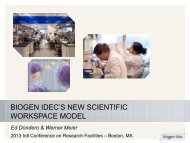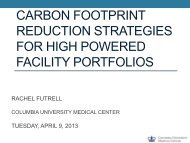Animal Research Facilities 2011 - Tradeline, Inc.
Animal Research Facilities 2011 - Tradeline, Inc.
Animal Research Facilities 2011 - Tradeline, Inc.
You also want an ePaper? Increase the reach of your titles
YUMPU automatically turns print PDFs into web optimized ePapers that Google loves.
12<br />
Monday and Tuesday; Nov. 7-8<br />
Attend seven of the 19 Forum Sessions on Pages 10-13<br />
J. New waste disposal technologies that<br />
improve performance and lower ops<br />
costs<br />
Progressive Recovery, <strong>Inc</strong>.<br />
Shanon D. Jones – Bio Division General Manager<br />
Gary W. Schmidt – Account Manager<br />
Lower capital and operating costs and greater energy efficiency for<br />
animal research facilities can be achieved through the use of new<br />
solid waste disposal technologies. In this session, see specifications<br />
and criteria for selecting a waste disposal technology and particular<br />
infrastructure decisions that support it. Shanon Jones and Gary<br />
Schmidt detail how the new technologies work, and they set out<br />
findings and data on systems performance, energy use, labor, and<br />
capital along with the facility planning implications and specific<br />
sterilization processes. They illustrate how the technology is operated<br />
as well as a specific sterilization process. AIA HSW<br />
Monday 2:25 p.m. – 3:20 p.m.<br />
K. <strong>Animal</strong> facility design, operational<br />
features to increase workforce<br />
efficiency, reduce labor losses<br />
University of Michigan Medical School<br />
Robert Dysko, DVM – Associate Director, Unit for Laboratory <strong>Animal</strong> Medicine<br />
This session examines facility features that increase vivarium<br />
worker productivity and reduce losses due to injury, inefficiency, and<br />
retraining. Robert Dysko, recent AALAS president and the associate<br />
director of University of Michigan Medical School’s vivarium, identifies<br />
workforce centered animal facility upgrades that ease staffing<br />
challenges, increase operating efficiencies, and improve employee<br />
morale. He examines strategic investments in improved ergonomics<br />
for repetitive tasks, workplace environment enhancements, and<br />
automation. He highlights specific features, amenities, and programs<br />
that are proving key to maintaining a satisfied and injury-free<br />
workforce. AIA HSW<br />
Tuesday 10:35 a.m. – 11:30 a.m.<br />
Renovations, upgrades, and new<br />
construction (L-O)<br />
L. Building Information Modeling (BIM)<br />
payoffs for animal facility operations<br />
and construction<br />
Louviere, Stratton & Yokel, LLC<br />
Uri Yokel, AIA, LEED AP – Principal<br />
William Cleaveland, RA, LEED AP – Architect<br />
Building Information Modeling (BIM) is now being applied to animal<br />
facilities to save money on capital projects and also to run facilities<br />
more efficiently with lower operating costs. Here, Uri Yokel and<br />
William Cleaveland demonstrate the applications and the results.<br />
Using real-life recent case examples, they illustrate the use of BIM to<br />
track vivarium energy use and cage and population densities as well<br />
as to facilitate commissioning, improve maintenance processes, and<br />
make future facility modifications easier. They examine BIM-enhanced<br />
project outcomes including higher sustainability, higher space<br />
utilization, lower per diems, faster startup, and lower maintenance<br />
costs. AIA HSW S<br />
Monday 1:15 p.m. – 2:10 p.m.<br />
AIA Sessions qualify for AIA credit. HSW Sessions qualify for HSW credit. S Sessions qualify for AIA sustainable design credit.<br />
M. Renovations and upgrades that<br />
improve vivarium space efficiency and<br />
operating performance<br />
The Clark Enersen Partners<br />
Shawn Diederich, PE, LEED AP – Senior Principal<br />
Gregory S. Lattig, AIA – Senior Principal<br />
Andrew G. Stepp – Senior Principal<br />
University of Nebraska – Lincoln<br />
Prem S. Paul, DVM, Ph.D. – Vice Chancellor for <strong>Research</strong> and Economic Development<br />
<strong>Animal</strong> facility renovation projects have two big operational<br />
objectives: better space utilization and keeping facilities operational<br />
and productive. Here, session leaders profile high-value upgrade<br />
strategies that bring new capabilities to outdated vivariums, and<br />
the facility condition assessment processes and renovation cost<br />
benchmarks for which to plan. They scope out the positive operating<br />
impact of upgraded HVAC systems, processes, and animal and worker<br />
flow. They examine design and cost considerations for renovations that<br />
must adhere to the NIH Design Requirements Manual, and they set out<br />
phasing techniques that keep the facility up and running and strategies<br />
that anticipate future upgrade needs. AIA HSW S<br />
Monday 11:10 a.m. – 12:05 p.m. | Tuesday 10:35 a.m. – 11:30 a.m.





